Tangalooma, Queensland
Originally a whaling station, Tangalooma Island Resort (formerly known as Tangalooma Wild Dolphin Resort) is a resort on the west side of Moreton Island in Queensland, Australia. It lies on the eastern shore of Moreton Bay and is known for its resort accommodation, dolphin-feeding program, sand dunes and wreck diving. Swimming is popular along the white beaches. It has a population of over 300 and receives more than 3500 visitors every week as it is only about 70 minutes from Brisbane by express catamaran. Moreton Island National Park is 98% of the island, though there are three small townships there: Bulwer, Kooringal and Cowan Cowan. The adjacent waters are protected as the Moreton Bay Marine Park.[1] Tangalooma is the aboriginal word meaning "where the fish gather".
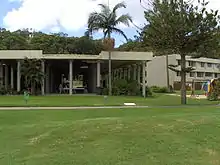
Whaling station
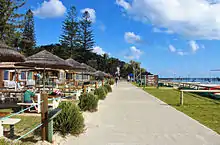
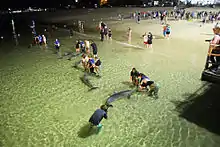
Tangalooma whaling station operated from 1952 until 1962, during which period it harvested and processed 6277 humpback whales. Whaling took place when the humpback whales migrated along the coast in winter, in an eight- to ten-week season during which the processing factory ran 24 hours a day. The operation was at first very successful, employing a crew of about 140 people, but, in its final years, a collapse in catch levels made it uneconomic to continue. When the station began whaling, the population of eastern Australian humpbacks was estimated at 10,000; when it ended, the number of whales had been reduced to an estimated 500. In 1963 the hunting of humpbacks was banned in Australian waters; since then the population has been recovering. Following the closure of the station, it was sold for resort development.[2][3]
Tangalooma Eco Centre
Formally known as the Tangalooma Marine Education and Conservation Centre, the Eco Centre promotes environmental awareness. Eco Rangers conduct education programs and nature-based tours to enhance visitors' awareness of the surrounding ecosystems.[1] The Eco Centre is based opposite the beach near the Tangalooma Jetty, where they operate the night wild dolphin feeding program for official guests of the resort.[4]
Tangalooma Island Resort
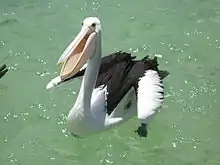
The resort (formerly known as Tangalooma Wild Dolphin Resort) is well known for the hand-feeding of wild dolphins. Every evening at sunset a pod of up to 11, local bottlenose dolphins swims to the beach in front of the resort where selected guests can feed them, an activity supervised by the Tangalooma Marine Education and Conservation Centre (TMECC).
Apart from the dolphin feeding program, there are many tours and other activities on offer, including whale watching cruises. Accommodation consists of about 300 rooms, as a variety of hotel units, villas and apartments. Sites for private housing are available on the sand hills behind the resort.[1]
As at April 2018, although the resort has rights to use the beach in front of the resort, it can not prevent the public from also using the beach.[5]
Tangalooma Ship Wrecks
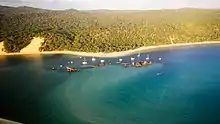
Located to the north of Tangalooma Island Resort is a total of 15 vessels that were deliberately scuttled between the 1960s through to the 1980s. These wrecks have now become a man-made ecosystem providing a haven for local marine life including dolphins, sea turtles, wobbegongs and over 200 species of fish. The Wrecks are popular with boats as they provide a calm place to anchor and are known as a great snorkeling location.[6][7]
In popular culture
The film Scooby Doo (2002) was filmed here. Tangalooma was referred to as Spooky Island in the film.[8]
See also
References
- RACQ. (1980). Seeing South-East Queensland (2nd ed.). RACQ ISBN 0-909518-07-6
- Orams, Mark B.; & Forestell, Paul H. From whale harvesting to whale watching. Tangalooma 30 years on. Archived 2008-10-14 at the Wayback Machine
- National Archives of Australia. Image no.: A12111, 1/1960/16/156
- "Tangalooma Marine Education & Conservation". www.tangalooma.com. Archived from the original on 3 September 2018. Retrieved 3 September 2018.
- "I refer to your email received 13 April 2018 to the Department of Natural Resources Mines and Energy (DNRME) regarding beach access at Tangalooma, Moreton Island. Your concerns were referred to me for reply. Tangalooma resort holds a lease over an area of Moreton Island described as NCL 6/2593 Lot 8 on SL8209 and Lot 25 on SP237385 which is surveyed to the high water mark. The land that forms the beach between high water mark and low water mark abutting the western boundary of Lot 8 on SL8209 has a permit to occupy over it also held by the resort. The resort was first granted this permit to occupy approximately 40 years ago and, under the conditions of the permit, is allowed to fence the northern and southern boundaries. This was permitted as a safety measure to protect users of the beach from vehicles that would have normally used the beach were it open to traffic. It is generally not the government’s policy to extend occupancy rights to low water mark. At the time, the resort’s situation was considered exceptional as mixing large numbers of people using the beach with four wheel drive vehicles travelling the beach was not considered to be in the best interests of public safety. However, as you have correctly stated, the permit to occupy does not give the resort exclusive rights to occupy the beach. The general public are entitled to access the beach in front of the resort by boat or on foot at all times. Officers of DNRME will take this issue up with resort management. Provided by the Principal Land Officer, DNRME 20 April 2018 and published by Lisa Wilkins
- "Tangalooma Wrecks | Moreton Island Visitor Information and Tourism Website". www.visitmoretonisland.com. Archived from the original on 3 November 2017. Retrieved 3 November 2017.
- "Tangalooma Wrecks". Tangalooma Island Resort. Archived from the original on 3 November 2017. Retrieved 3 November 2017.
- Motherwell, Sarah (12 November 2015). "Where you can recreate your favourite movie scenes in Queensland". Brisbane Courier-Mail. Archived from the original on 24 July 2018. Retrieved 28 April 2019.
Further reading
- Jones, David (1980). The Whalers of Tangalooma. Melbourne: Nautical Association of Australia. ISBN 0959907912.